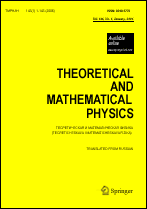|
Quasifree States in Some One-Dimensional Quantum Spin Models
Yu. G. Stroganov
Institute for High Energy Physics
Abstract:
We use numerical methods to investigate the SUq(N) Perk–Schultz spin chain at the special quantum parameter value q=−eiπ/N. We discover simple laws applicable to a considerable part of the Hamiltonian spectrum, which in particular contains the energy of the ground state and the nearest excitations. The phenomenological formulas obtained resemble formulas for the spectrum of the free-fermion model. We formulate several hypotheses, some of which can be justified by constructing exact solutions of the system of Bethe-ansatz equations for finite-length chains. We obtain two sets of solutions of these equations. The first corresponds to the special value of the quantum parameter q and, in particular, describes the model ground state, which is antiferromagnetic. The second set of solutions describes a part of the spectrum belonging to the sectors where the numbers ni of particles of different types (i=0,1,…,N−1) do not exceed unity for all the types except one. For this set, we obtain a simple spectrum at arbitrary values of q. It is hypothesized that this spectrum and the solutions of the Bethe-ansatz equations found in a closed form are intimately related to the existence of a special eigenstate for the transfer matrix of the auxiliary inhomogeneous SUq(N−1) vertex model that is involved in constructing the system of Bethe-ansatz equations of a matrioshka structure. Indirect arguments based on combinatorial properties of the wave function of the relevant state are given to support this hypothesis.
Keywords:
Perk–Schultz model, finite spin chains, exact solution of Bethe, nsatz equations.
Citation:
Yu. G. Stroganov, “Quasifree States in Some One-Dimensional Quantum Spin Models”, TMF, 139:1 (2004), 112–128; Theoret. and Math. Phys., 139:1 (2004), 542–556
Linking options:
https://www.mathnet.ru/eng/tmf46https://doi.org/10.4213/tmf46 https://www.mathnet.ru/eng/tmf/v139/i1/p112
|


| Statistics & downloads: |
| Abstract page: | 398 | | Full-text PDF : | 212 | | References: | 69 | | First page: | 1 |
|




 Contact us:
Contact us: Terms of Use
Terms of Use
 Registration to the website
Registration to the website Logotypes
Logotypes









 Citation in format
Citation in format 